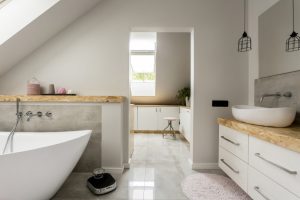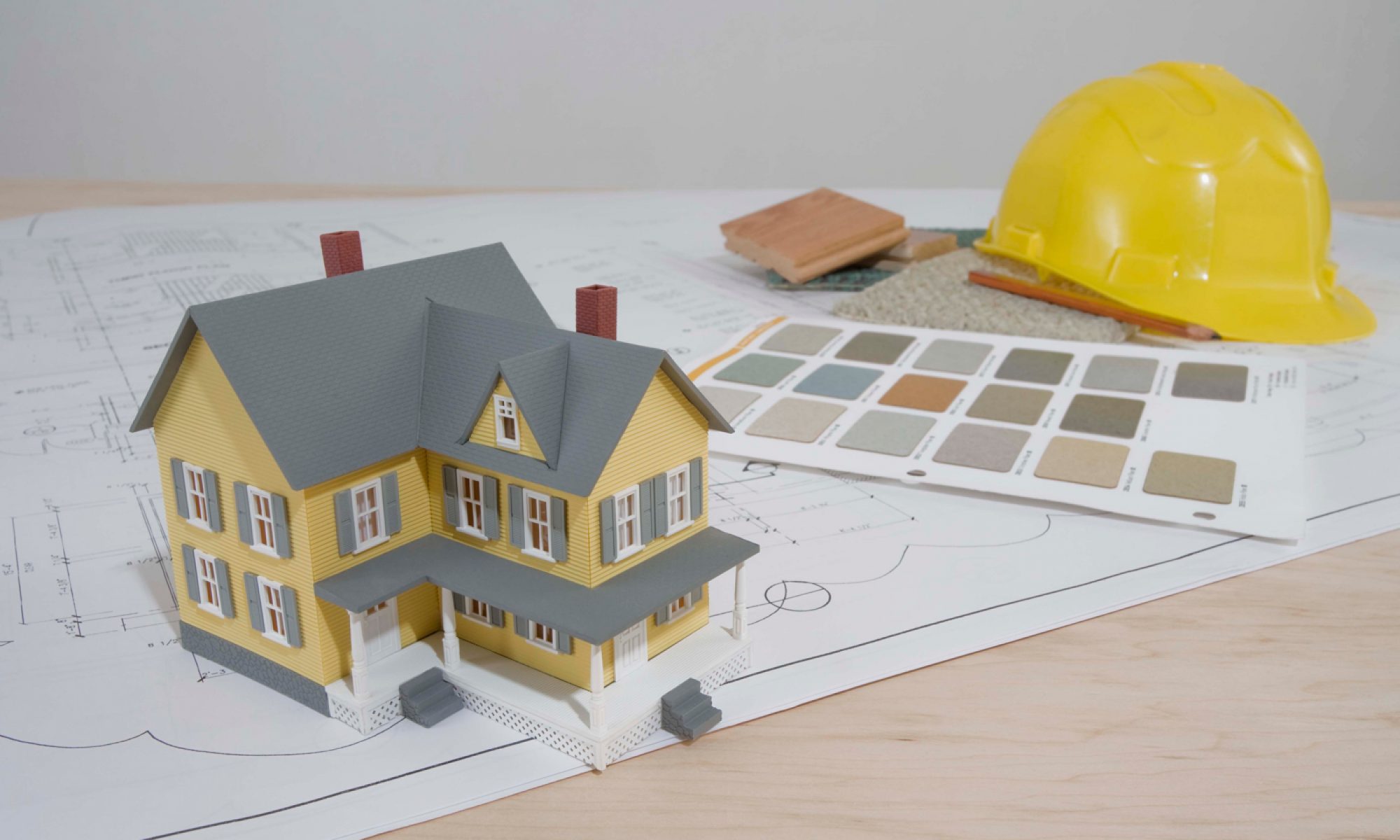 Raleigh-based DIYer Brittany Bailey, a Northern Virginia native who blogs at Pretty Handy Girl, decided to invest roughly $20,000 on the outside of her house. (Lissa Gotwals/For The Washington Post)
Raleigh-based DIYer Brittany Bailey, a Northern Virginia native who blogs at Pretty Handy Girl, decided to invest roughly $20,000 on the outside of her house. (Lissa Gotwals/For The Washington Post)Suppose you suddenly came into a nice sum of no-strings-attached money. Perhaps you received an unanticipated tax refund or a surprisingly generous year-end bonus. Or maybe a relative died, leaving you a lavish bequest.
Whatever the source, you probably have no shortage of ideas on how to spend it. For most people, it’s a list of competing priorities: finally taking care of that lingering student loan, making a deposit in a child’s college savings account, investing in the booming stock market, or just putting it in the bank and finally relaxing about expenditures after a long spell of scrimping.
But what about your house? It is, after all, the biggest investment most families make, and money spent improving it is generally borne out later in resale value. Just as important, most people spend more time in their house than anywhere else, and making sure it’s genuinely comfortable, and not just functional, can go a long way toward boosting your quality of life.
The question is where to begin. The choices are many, and each has its own price tag and set of variables attached to it. That’s where the experts come in. We talked to a number of contractors, landscape architects, do-it-yourselfers and interior designers to hear their recommendations and get a sense of the possibilities at several price points: $7,000, $20,000 and $50,000.
Obviously, it’s not one-size-fits-all. The cost and caveats for a 1,200-square-foot Capitol Hill rowhouse will be very different than for a 5,000-square-foot house in Potomac, Md. Prices also vary widely depending on materials and on whether you do the work yourself or hire someone else to do it. So consider these suggestions as guides, rather than definitive prescriptions.
If resale value is a key consideration, homeowners will probably want to focus on a few specific options.
“If I were to say spend money on any one thing, it would be the kitchen — and the bathroom if you have extra money,” says Jonathan Montgomery, an appraiser with the Real Estate Appraisal Group, a Takoma Park-based business. “But anything you can do to improve the look of the home, that’s where you spend the money.”
If you’re not planning to move anytime soon, though, you might have different considerations. And what these ideas highlight are that the best changes aren’t necessarily the big-ticket items. Those can be satisfying, but there are a number of more subtle improvements that can dramatically improve the feeling and value of a house.
$7,000
It might not seem like a lot of money, but $7,000, used well, can have a substantial impact on a house. The question is where to direct it.
“At $7,000, that’s typically where you’re thinking of doing a minor improvement or upgrade to a large area, or a major overhaul to a small area,” says John Petersik, half of the Richmond-based duo chronicling their DIY adventures at Young House Love.
For many people, the kitchen — often a relatively large space — is their first thought. It’s a room that’s used frequently and that might have a public function, as well. Unfortunately, $7,000 doesn’t go far when it comes to replacing old appliances with shiny new ones. But if you’re willing to do some of the work yourself, it’s still possible to have a considerable effect.
“You can redo the kitchen counters and paint the cabinets to refresh the look,” Petersik said. “It’s not a full remodel, but gives you a fresh space.”
You’d have to paint your own cabinets — “If you hire someone, it’s almost as much [money] as getting new cabinets,” says his wife, Sherry Petersik. Although it’s tedious, it’s not particularly hard work. The bulk of the money can be spent on countertops, which, depending on the size of the kitchen, could be low-budget Ikea butcher block, granite or somewhere in between. And if there’s money left over, you can add a simple peel-and-stick tile backsplash or a cute light fixture to gussy things up.
The same amount could be used to upgrade a small bathroom, taking it down to the studs and adding new tile, redoing the shower and upgrading the fixtures. At that price range, the renovation wouldn’t be fancy, but it could include several new elements.
“We converted a half-bath in our basement to a full bath,” says Christopher Bulka, a D.C. real estate agent, speaking of his former house in Mount Vernon Square. He and his husband hired a contractor to turn an adjacent closet into a shower; the final result, which cost roughly $7,000, included not only the tiled shower, but also a new vanity and light fixture. “The majority of the cost with this was labor — tile is expensive to put in,” Bulka said.
But $7,000 can also be used strategically for a more subtle but impactful result. If your house has hardwood floors that are old, scratched or otherwise not at their best, you could hire someone to refinish them. Once the furniture goes back in, every room would look a little fresher.
Or, you could use the funds for a twofold improvement that similarly brightens up the house. First, paint the home’s interior. Then hire a designer to help improve the lighting, particularly in more public spaces such as the living and dining rooms, where good lighting can enhance the space. “In over 20 years of working with clients, I have yet to walk into a home that was properly lit,” says Debbie Wiener, who runs Designing Solutions in Silver Spring. “Most of us are mostly home at night, when there’s very little light. That’s why lighting is so impactful.”
$20,000
With $20,000, you could take on one of the most popular renovations: a full upgrade of a kitchen or bathroom. For a kitchen, $20,000 would be enough for a mid-level redo: new counters, cabinets, sink and a couple of upgraded appliances. That money would go further if you bought the cabinets ready-to-assemble and hired someone to install them.
Or, you could seriously upgrade a medium-size bathroom, renewing everything and potentially adding luxuries such as a steam shower, heated floor or free-standing tub.
But there are less-obvious areas that might also need attention. “For $20,000, depending on the size of the house, you can replace your windows,” says David Robertson, who runs Something Different Contracting in the District. It’s not a particularly glamorous investment, but it can be necessary, if the house is leaking hot or cold air or simply looks dated. It’s difficult to estimate how much a full set of window replacements costs, Robertson said. It depends on how many windows the home has, plus whether you want to go with vinyl or wood; the latter will cost more. But $20,000 should be enough for nice-quality windows in an average-size house.
 Bailey and her husband hired a landscape architect to redo the back yard, a project that included tiling a 280-square foot patio with pavers and adding a low wall, path and plants. (Lissa Gotwals/For The Washington Post)
Bailey and her husband hired a landscape architect to redo the back yard, a project that included tiling a 280-square foot patio with pavers and adding a low wall, path and plants. (Lissa Gotwals/For The Washington Post)
Raleigh, N.C.-based DIYer Brittany Bailey, a Northern Virginia native who blogs at Pretty Handy Girl, decided to invest roughly that sum on the outside of her house.
“Exterior landscaping: patio, retaining walls, stone stuff,” she said.
Bailey and her husband hired a landscape architect to redo the back yard, a project that included tiling a 280-square-foot patio with pavers and adding a low wall, path and plants. They spent about $800 on the design and about $20,000 on the entire project. Bailey saved money by making a wooden arbor and pergola herself for $500.
The price will depend on how fancy you want to go, and the cost of plants varies greatly: a mature tree can be as much as $2,000, Bailey said. But taking on some of that work yourself or seeking out a wholesale nursery could reduce the price.
Bailey has another suggestion for homeowners looking to seriously protect the value of their homes: tackling those deferred maintenance jobs.
“As unexciting as it sounds, I highly recommend making sure that all the standard maintenance is done on the house,” she said. “So if you have water issues — like a leaky roof or under the house — that’s the kind of stuff you really need to put money into.”
That might mean replacing the roof, getting the gutters repaired, having the siding painted or finally getting to the bottom of why the basement is so damp. There’s no real estimate for how much those repairs might cost; the price depends on the state of the house. But $20,000 could probably take care of most of them, with enough left over for a fun splurge.
$50,000
With $50,000, a homeowner can afford a dream renovation, such as a high-end kitchen remodel that includes top-of-the-line appliances and cabinetry. Another option would be to add to the house’s usable space by turning a screened porch or garage into a fully finished interior room.
Bulka, the D.C. real estate agent, combined those two jobs at his current home, a Bloomingdale rowhouse. “This house had a sleeping porch on the back, and it wasn’t super usable,” he said. Meanwhile, the kitchen — which abutted the porch — was already gutted when he and his husband bought the house and was essentially a blank slate. With the help of contractor Robertson and his Something Different Contracting team, they broke through the wall, enclosed the porch and converted it into one large kitchen with new cabinets and appliances.
 With a $50,000 renovation budget, you can hire a designer to give you a custom look. (nicolamargaret/Getty Images)
With a $50,000 renovation budget, you can hire a designer to give you a custom look. (nicolamargaret/Getty Images)
But you don’t have to cut into walls to make a dramatic impact. Maybe decorating isn’t your thing: You don’t have the time or ability to furnish your living and dining rooms in a way that you like. For $50,000, an interior designer can help you choose a look and pick out furniture and accessories that will make the rooms shine.
“That amount allows you to do the extras,” said Wiener, of Designing Solutions, who estimates that about 10 percent of that budget would go to the designer; the rest could be spent on furnishings. “Not just the rug, sofa, coffee table and media cabinet, but also maybe some great lights, a bookcase and great window treatments. The good stuff always costs more.”
And don’t forget the home’s exterior. Mark White, who runs Arlington’s Gardenwise landscape design firm, says $50,000 can transform a small back yard — say, the 400- or 500-square-foot space behind a D.C. rowhouse. “We can make the garden space an extension of the house,” he said.
That’s just what Doug Hattaway did in the back yard of his Dupont Circle rowhouse, which had been dominated by a giant second-story deck.
After removing the deck, he hired Gardenwise to redesign the space.
The result is an outdoor area tiled with flagstone and granite that includes planters, a couch, a gas grill and a small fountain.
“It feels like a cozy room,” said Hattaway, whose family uses the space virtually year-round.
“It’s really nice to walk in and see the space and the trees; it’s soothing to look at and be in.”
Original Source: https://www.washingtonpost.com/realestate/remodeling-as-an-investment-getting-the-most-for-your-money/2018/06/26/57240e54-73f1-11e8-b4b7-308400242c2e_story.html?noredirect=on&utm_term=.3e74c1fe1e40
Original Date: June 28 2018
Written By: Amanda Abrams



